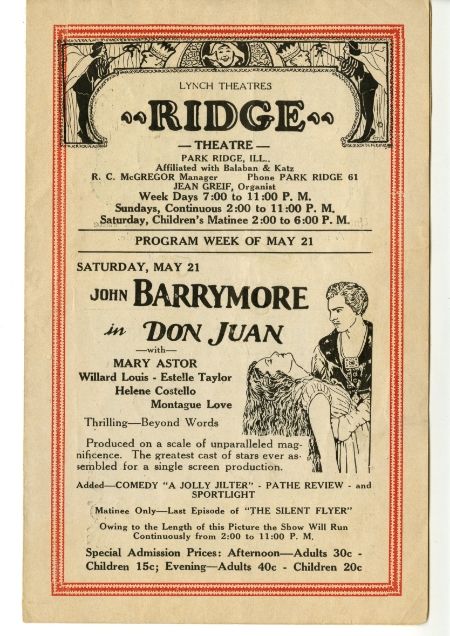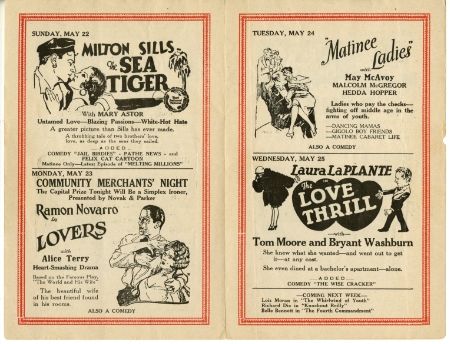The Ridge Theatre– Park Ridge’s first movie house.

The Pickwick Theatre is the most identifiable landmark in Park Ridge. It’s been a source of pride for the community since 1928. Filling the theatre, however, is not always an easy task. Suburban multiplexes and the repertoire theatres of Chicago provide stiff competition for the Pickwick. Within this milieu, the Pickwick Theatre Classic Film Series strives to bring in good “box office.” But once upon a time, the Pickwick’s closest competitor was right here in Park Ridge. Few people today realize a second movie house once existed in town. In fact, it had been built years earlier. For those who appreciate the glorious movie theatres of yesteryear, we thought we’d post a few words about the forgotten “Ridge Theatre.”
The Ridge Theatre was located across Hodges Park at 203 Vine Avenue (next to the building which now rents to the d’Vine beauty salon). It was constructed by the Park Ridge Amusement Company and designed by architect Elmer F. Behrns (1896-1975), who had worked on many movie theatres in Illinois, including the Egyptian in DeKalb and the Woodstock Theatre. Unlike the Pickwick’s modernistic style, the Ridge Theatre’s terra cotta facade distinctly recalled Spanish Colonial, and it was nearly identical to the York Theatre in Elmhurst. The York, which was also designed by Behrns, opened in 1924. Though we have no photos of the inside of the Ridge Theatre, we know that it, too, was patterned after the York. The interior design was done in the style of the French Renaissance and was supervised by John Paulding and the McPherson Decorating Company. The interior included a dome decorated in silver-leaf that also featured a three-color lighting scheme. The rear wall of the theatre was near the Chicago & Northwestern Railroad, which may have affected the acoustics during performances. But any screening would’ve certainly been enhanced by the $15,000 Gottfried pipe organ that had been installed.
The Ridge was originally part of the Chicago-based Lynch theatre holdings. “Lynch Theatres” receives top billing above Ridge Theatre on the programs; it was affiliated with and operated by Balaban & Katz. According to a 1931 edition of the Film Daily Year Book of Motion Pictures, the Ridge seated 1200 while the Pickwick had 800 seats. This is inaccurate since the original design for the Pickwick had nearly 1600 seats. By 1941, years after the Ridge had closed, the seating capacity of the older theatre had dropped and was reduced to 800. (The Pickwick’s seating capacity, meanwhile, would eventually drop to 1400, and today it is currently at 950 with the newer seats.) Though the Ridge was a good-sized neighborhood theatre, William H. Malone, the town’s second mayor and eventual developer of the Pickwick, thought the Ridge was simply not big enough. (The population of Park Ridge in 1928 was considerably less than 10,000.)
The Ridge opened its doors just over ninety years ago on November 15, 1924– four years before the Pickwick. The first film shown was the silent movie Her Night of Romance, which starred Constance Talmadge and Ronald Colman. The mayor at the time, E. Leslie Cole, was there to greet the Opening Night crowd. The theatre operated on weekdays from 7:00 to 11:00 PM; Sundays 2 to 11 PM, and there was a children’s matinee on Saturdays from 2:00 to 6:00 PM. General admission was normally “15c for children and 35c for adults.” The programs that have survived reveal a theatre operating at the height of the silent era in the late 1920s. The movie ads feature names like Ronald Colman (Beau Geste), Harold Lloyd (Speedy), Dorothy Gish (Madame Pompadour), Renee Adoree (Back to God’s Country), Victor McLaglen (The River Pirate), Myrna Loy (State Street Sadie), Lewis Stone (Freedom of the Press), Mary Philbin (Surrender), John Gilbert (The Big Parade), and hundreds of others. These silent films were given a voice thanks to the impressive Gottfried organ. Programs from the era (see below), reveal that several house organists performed on it during the course of the year.
A typical evening might include a double feature program, a “Junior Fun Frolic,” or a Chinaware Night (“Free Chinaware to the Ladies.”) Whereas today you might pay $12 to see TV commercials, back then you could see a comedy, a newsreel, and a movie serial chapter with the feature presentation. A wonderful ad for the jungle adventure Chang (1927) lists the added attraction of a “Crazy Cat Cartoon and Paramount News.” Though the programs are simple bi-folds made up of silent movie artwork, they conjure up a strong sense of time and place. There was genuine excitement to be found with previews like: “Coming Next Week: Lon Chaney in The Unknown.” A handful of other film stars and their films might also be listed for the following week.
The theatre was managed by Robert C. McGregor (1884-1954), who was also part owner. (Years afterward, he became an alderman in Park Ridge.) In The History of Park Ridge, author Orvis Jordan writes, “The Greater Chicago Magazine was enthusiastic over the modernity of the new show house. It had oil heat, which had only recently come to Park Ridge. It also had washed air. The entire output of United Artists, Paramount, First National, Universal and Fox was controlled, though not all of this output was used, for under McGregor no picture that would offend public taste was shown.”
A 1928 advertisement in the Exhibitors Herald and Moving Picture World for the Kohler Electric Plant. Note the films on the marquee: The Big City with Lon Chaney and The Crowd. The building also included retail space for a lingerie and hosiery business.
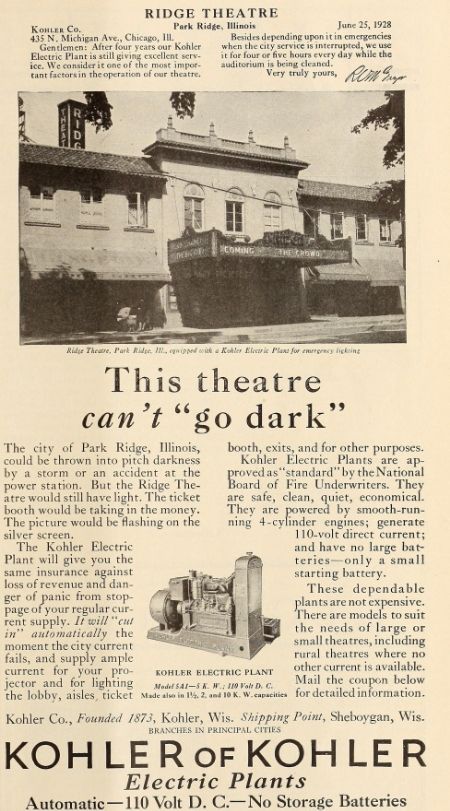
Pickwick Theatre owner William H. Malone (1877-1956) eventually bought out his competitor, forcing The Ridge to go dark. It closed its doors around 1936. The Ridge made a brief comeback in the mid-1950s as an art house– renamed the Park Avenue Cinema– but it was a short-lived venture. In 1956 the theatre was converted to a Michael Kirby ice skating studio. The skating rink lasted until 1973. Then, ten years later in 1983, a condominium complex went up on the site of the old theatre. No doubt most people today, making their way along Vine to City Hall and the residential area, would never guess that a theatre had once stood there. Sadly, nothing visible remains. Even the Gottfried organ became a thing of the past. (If this instrument was relocated, it never survived to the present day.)
For more information about the Ridge and the era of American movie palaces, visit the following website: www.historictheatres.org.
The covers of two weekly programs. The Ridge Theatre operated in the heyday of the silent film era.
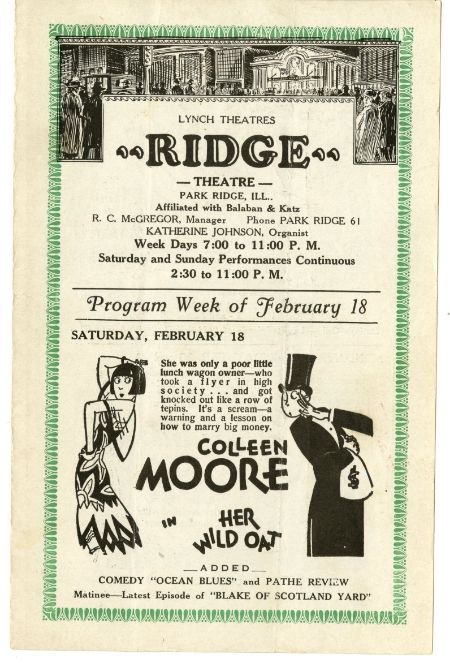
The inside of two other programs…
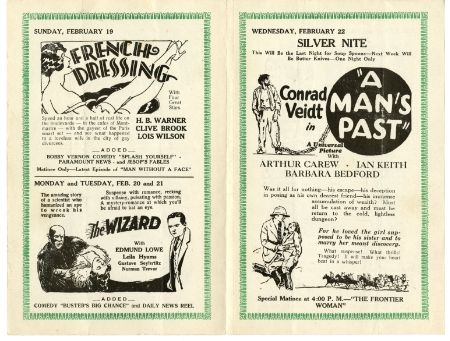
Another angle of the Ridge Theatre (left) with the Park Ridge News Company staff. (The news office was next to the theatre.)
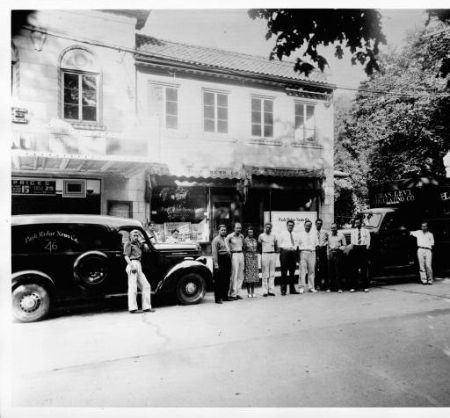
The York Theatre in Elmhurst resembled the Ridge Theatre and was designed by the same architect.

Special thanks to Paul Adlaf of the Park Ridge Historical Society, the Reference staff of the Park Ridge Public Library, and Elizabeth Rye (who first asked me about the Ridge Theatre after seeing it listed in her copy of the Film Daily Year Book).
~M.C.H.
“Mr. McGregor exhibits the best pictures to be had, and only the best. The Ridge Theatre is a community house, so safe that children can attend alone.” ~ The Greater Chicago Magazine
